Plasmonic Nanocomposites of ZnO-Ag Produced by Laser Ablation and Their Photocatalytic Destruction of Rhodamine, Tetracycline and Phenol
Abstract
1. Introduction
2. Results and Discussion
2.1. Structure and Morphology of NPs
2.2. Electrokinetic Properties
2.3. Optical Properties of NPs
2.4. Photocatalytic Properties of NPs
2.4.1. Photocatalytic Decomposition of Rh B
2.4.2. Photocatalytic Decomposition of Tetracycline
2.4.3. Photocatalytic Decomposition of Phenol
3. Research Methods and Material Preparation
3.1. Obtaining Materials Using PLA
3.2. Research Methods
3.3. Photocatalytic Experiment
4. Conclusions
Supplementary Materials
Author Contributions
Funding
Institutional Review Board Statement
Informed Consent Statement
Data Availability Statement
Acknowledgments
Conflicts of Interest
Sample Availability
References
- Vargas-Berrons, K.; Bernal-Jacome, L.; de Leon-Martinez, L.D.; Flores-Ramirez, R. Emerging pollutants (EPs) in Latin América: A critical review of under-studied EPs, case of study -Nonylphenol-. Sci. Total Environ. 2020, 726, 138493. [Google Scholar] [CrossRef] [PubMed]
- Lellis, B.; Favaro-Polonio, C.Z.; Pamphile, J.A.; Polonio, J.C. Effects of textile dyes on health and the environment and bioremediation potential of living organisms. Biotechnol. Res. Innov. 2019, 3, 275–290. [Google Scholar] [CrossRef]
- Mohod, A.V.; Momotko, M.; Shah, N.S.; Marchel, M.; Imran, M.; Kong, L.; Boczkaj, G. Degradation of Rhodamine dyes by Advanced Oxidation Processes (AOPs)–Focus on cavitation and photocatalysis–A critical review. Water Resour. Ind. 2023, 30, 100220. [Google Scholar] [CrossRef]
- Ore, O.T.; Adeola, A.O.; Bayode, A.A.; Adedipe, D.T.; Nomngongo, P.N. Organophosphate pesticide residues in environmental and biological matrices: Occurrence, distribution and potential remedial approaches. JECE 2023, 5, 9–23. [Google Scholar] [CrossRef]
- Yadav, G.; Ahmaruzzaman, M. Recent development of novel nanocomposites for photocatalysis mediated remediation of phenolic derivatives: A comprehensive review. J. Ind. Eng. Chem. 2023, 127, 18–35. [Google Scholar] [CrossRef]
- Pokharel, S.; Shrestha, P.; Adhikari, B. Antimicrobial use in food animals and human health: Time to implement ‘One Health’ approach. Antimicrob. Resist. Infect. Control 2020, 9, 181. [Google Scholar] [CrossRef] [PubMed]
- Ganguly, P.; Byrne, C.; Breen, A.; Pillai, S.C. Antimicrobial activity of photocatalysts: Fundamentals, mechanisms, kinetics and recent advances. Appl. Catal. B 2018, 225, 51–75. [Google Scholar] [CrossRef]
- Mashra, S.; Sundaram, B. A review of the photocatalysis process used for wastewater treatment. Mater. Today Proc. 2023. [Google Scholar] [CrossRef]
- Al-Mamun, M.R.; Kader, S.; Islam, M.S.; Khan, M.N. Photocatalytic activity improvement and application of UV-TiO2 photocatalysis in textile wastewater treatment: A review. J. Environ. Chem. Eng. 2019, 7, 103248. [Google Scholar] [CrossRef]
- Dhiman, P.; Rana, G.; Kumar, A.; Sharma, G.; Vo, D.-V.N.; Naushad, M. ZnO-based heterostructures as photocatalysts for hydrogen generation and depollution: A review. Environ. Chem. Lett. 2020, 20, 1047–1081. [Google Scholar] [CrossRef]
- Li, Z.; Wang, S.; Wu, J.; Zhou, W. Recent progress in defective TiO2 photocatalysts for energy and environmental applications. Renew. Sustain. Energy Rev. 2022, 156, 111980. [Google Scholar] [CrossRef]
- Rajaram, P.; Jeice, A.R.; Jayakumar, K. Review of green synthesized TiO2 nanoparticles for diverse applications. Surf. Interfaces 2023, 39, 102912. [Google Scholar] [CrossRef]
- Weldegebrieal, G.K. Synthesis method, antibacterial and photocatalytic activity of ZnO nanoparticles for azo dyes in wastewater treatment: A review. Inorg. Chem. Commun. 2020, 120, 108140. [Google Scholar] [CrossRef]
- Jiang, Z.; Lui, B.; Yu, L.; Tong, Y.; Yan, M.; Znang, R.; Han, W.; Hao, Y.; Shanggoun, L.; Zhang, R.; et al. Research progresses in preparation methods and applications of zinc oxide nanoparticles. J. Alloys Compd. 2023, 956, 170316. [Google Scholar] [CrossRef]
- Nachit, W.; Ait Ahsaine, H.; Ramzi, Z.; Touhtouh, S.; Goncharova, I.; Benkhouja, K. Photocatalytic activity of anatase-brookite TiO2 nanoparticles synthesized by sol gel method at low temperature. Opt. Mater. 2022, 129, 112256. [Google Scholar] [CrossRef]
- Wu, Z.-Y.; Xu, Y.-J.; Huang, L.-J.; Znang, Q.-X.; Tang, D.-L. Fullerene-cored star-shaped polyporphyrin-incorporated TiO2 as photocatalysts for the enhanced degradation of rhodamine B. J. Environ. Chem. Eng. 2021, 9, 106142. [Google Scholar] [CrossRef]
- Andronic, L.; Lelis, M.; Enesca, A.; Karazhanov, S. Photocatalytic activity of defective black-titanium oxide photocatalysts towards pesticide degradation under UV/VIS irradiation. Surf. Interfaces 2022, 32, 102123. [Google Scholar] [CrossRef]
- Nair, P.R.; Ramirez, C.R.S.; Pinilla, M.A.G.; Krishnan, B.; Avellaneda, D.A.; Pelaes, R.F.C.; Shaji, S. Black titanium dioxide nanocolloids by laser irradiation in liquids for visible light photo-catalytic/electrochemical applications. Appl. Surf. Sci. 2023, 623, 157096. [Google Scholar] [CrossRef]
- Madhavi, V.; Kondaiah, P.; Mahan Rao, G. Influence of silver nanoparticles on titanium oxide and nitrogen doped titanium oxide thin films for sun light photocatalysis. Appl. Surf. Sci. 2018, 436, 708–719. [Google Scholar] [CrossRef]
- Thongam, D.D.; Chanturvdi, H. Heterostructure charge transfer dynamics on self-assembled ZnO on electronically different single-walled carbon nanotubes. Chemosphere 2023, 323, 138239. [Google Scholar] [CrossRef]
- Kanakkillam, S.S.; Krishnan, B.; Pelaez, R.F.C.; Martinez, J.A.A.; Avellaneda, D.A.; Shaji, S. Hybrid nanostructures of Ag/Au-ZnO synthesized by pulsed laser ablation/irradiation in liquid. Surf. Interfaces 2021, 27, 101561. [Google Scholar] [CrossRef]
- Kumaravel, V.; Mathew, S.; Bartlett, J.; Pillai, S.C. Photocatalytic hydrogen production using metal doped TiO2: A review of recent advances. Appl. Catal. 2019, 244, 1021–1064. [Google Scholar] [CrossRef]
- Panayotov, D.A.; Frenkel, A.I.; Morris, J.R. Catalysis and photocatalysis by nanoscale Au/TiO2: Perspectives for renewable energy. ACS Energy Lett. 2017, 2, 1223–1231. [Google Scholar] [CrossRef]
- Hou, W.; Cronin, S.B. A review of surface plasmon resonance-enhanced photocatalysis. Adv. Funct. Mater. 2013, 23, 1612–1619. [Google Scholar] [CrossRef]
- He, W.; Kim, H.K.; Wamer, W.G.; Melka, D.; Callahan, J.H.; Yin, J.J. Photogenerated charge carriers and reactive oxygen species in ZnO/Au hybrid nanostructures with enhanced photocatalytic and antibacterial activity. J. Am. Chem. Soc. 2014, 136, 750–757. [Google Scholar] [CrossRef] [PubMed]
- Li, H.; Ding, J.; Cai, S.; Zhang, W.; Zhang, X.; Wu, T.; Wang, C.; Foss, M.; Yang, R. Plasmon-enhanced photocatalytic properties of Au/ZnO nanowires. Appl. Surf. Sci. 2022, 583, 152539. [Google Scholar] [CrossRef]
- Liu, H.; Liu, H.; Yang, J.; Zhai, H.; Liu, X.; Jia, H. Microwave-assisted one-pot synthesis of Ag decorated flower-like ZnO composites photocatalysts for dye degradation and NO removal. Ceram. Int. 2019, 45, 20133–20140. [Google Scholar] [CrossRef]
- Adhikari, S.; Banerjee, A.; Eswar, N.K.; Sarkar, D.; Madras, G. Photocatalytic inactivation of E. coli by ZnO–Ag nanoparticles under solar radiation. RSC Adv. 2015, 5, 51067–51077. [Google Scholar] [CrossRef]
- Forsythe, R.C.; Cox, C.P.; Wilsey, M.K.; Müller, A.M. Pulsed Laser in Liquids Made Nanomaterials for Catalysis. Chem. Rev. 2021, 121, 7568–7637. [Google Scholar] [CrossRef]
- Mussin, A.; AlJulaih, A.A.; Mintcheva, N.; Aman, D.; Iwamori, S.; Gurbatov, S.O.; Bhardwaj, A.K.; Kulinich, S.A. PLLA nanosheets for wound healing: Embedding with iron-ion-containing nanoparticles. Nanomanufacturing 2023, 3, 401–415. [Google Scholar] [CrossRef]
- Amendola, V.; Amans, D.; Ishikawa, Y.; Koshizaki, N.; Scire, S.; Compagnini, G.; Reichenberger, S.; Barcikowski, S. Room-Temperature Laser Synthesis in Liquid of Oxide, Metal-Oxide Core-Shells, and Doped Oxide Nanoparticles. Chem. Eur. J. 2020, 26, 9206–9242. [Google Scholar] [CrossRef] [PubMed]
- Shabalina, A.V.; Fakhrutdinova, E.D.; Golubovskaya, A.G.; Kuzmin, S.M.; Koscheev, S.V.; Kulinich, S.A.; Svetlichnyi, V.A.; Vodyankina, O.V. Laser-assisted preparation of highly-efficient photocatalytic nanomaterial based on bismuth silicate. Appl. Surf. Sci. 2022, 575, 151722. [Google Scholar] [CrossRef]
- Yudasari, N.; Hardiansyh, A.; Herbani, Y.; Isnaeni; Auliyanti, M.M.; Djuhana, D. Single-step laser ablation synthesis of ZnO–Ag nanocomposites for broad-spectrum dye photodegradation and bacterial photoinactivation. J. Photochem. Photobiol. A 2023, 441, 114717. [Google Scholar] [CrossRef]
- Lapin, I.N.; Svetlichnyi, V.A. Features of the synthesis of nanocolloid oxides by laser ablation of bulk metal targets in solutions. Proc. SPIE 2015, 9810, 98100T. [Google Scholar] [CrossRef]
- Svetlichnyi, V.; Shabalina, A.; Lapin, I.; Goncharova, D. Metal Oxide Nanoparticle Preparation by Pulsed Laser Ablation of Metallic Targets in Liquid. In Applications of Laser Ablation-Thin Film Deposition, Nanomaterial Synthesis and Surface Modification, 1st ed.; Yang, D., Ed.; InTech: London, UK, 2016; Chapter 11; pp. 245–263. 426p, ISBN 978-953-51-2812-0. [Google Scholar] [CrossRef]
- Ali, H.; Ismail, A.M.; Menazea, A.A. Multifunctional Ag/ZnO/chitosan ternary bio-nanocomposites synthesized via laser ablation with enhanced optical, antibacterial, and catalytic characteristics. Water Process. Eng. 2022, 49, 102940. [Google Scholar] [CrossRef]
- Yudasari, N.; Anugrahwidya, R.; Tahir, D.; Suliyanti, M.M.; Herbani, Y.; Imawan, C.; Khalil, M.; Djuhana, D. Enhanced photocatalytic degradation of rhodamine 6G (R6G) using ZnO–Ag nanoparticles synthesized by pulsed laser ablation in liquid (PLAL). J. Alloys Compd. 2021, 886, 161291. [Google Scholar] [CrossRef]
- Anugrahwidya, R.; Yudasari, N.; Tahir, D. Optical and structural investigation of synthesis ZnO/Ag Nanoparticles prepared by laser ablation in liquid. Mater. Sci. Semicond. Process. 2020, 105, 1044712. [Google Scholar] [CrossRef]
- Elsayed, K.A.; Alomari, M.; Drmosh, Q.A.; Alheshibri, M.; Al Baroot, A.; Kayed, T.S.; Manda, A.A.; Al-Alotaibi, A.L. Fabrication of ZnO-Ag bimetallic nanoparticles by laser ablation for anticancer activity. Alex. Eng. J. 2022, 61, 1449–1457. [Google Scholar] [CrossRef]
- Jung, H.J.; Koutavarapu, R.; Lee, S.; Kim, J.H.; Choi, H.C.; Choi, M.Y. Enhanced photocatalytic degradation of lindane using metal–semiconductor Zn@ZnO and ZnO/Ag nanostructures. J. Environ. Sci. 2018, 74, 107–115. [Google Scholar] [CrossRef]
- Whang, T.-J.; Hsieh, M.-T.; Chen, H.-H. Visible-light photocatalytic degradation of methylene blue with laser-induced Ag/ZnO nanoparticles. Appl. Surf. Sci. 2012, 258, 2796–2801. [Google Scholar] [CrossRef]
- Ohtsuka, T.; Matsuda, M. In Situ Raman Spectroscopy for Corrosion Products of Zinc in Humidified Atmosphere in the Presence of Sodium Chloride Precipitate. Corros. Sci. 2003, 59, 407–413. [Google Scholar] [CrossRef]
- Svetlichnyi, V.A.; Lapin, I.N. Structure and properties of nanoparticles fabricated by laser ablation of Zn metal targets in water and ethanol. Russ. Phys. J. 2013, 56, 581–587. [Google Scholar] [CrossRef]
- Singh, S.B.; De, M. Room temperature adsorptive removal of thiophene over zinc oxide-based adsorbents. J. Mater. Eng. Perform. 2018, 27, 2661–2667. [Google Scholar] [CrossRef]
- Souri, D.; Tahan, Z.E. A new method for the determination of optical band gap and the nature of optical transitions in semiconductors. Appl. Phys. B 2015, 119, 273–279. [Google Scholar] [CrossRef]
- Gavrilenko, E.A.; Goncharova, D.A.; Lapin, I.N.; Gerasimova, M.A.; Svetlichnyi, V.A. Photocatalytic activity of zinc oxide nanoparticles prepared by laser ablation in a decomposition reaction of rhodamine B. Russ. Phys. J. 2020, 63, 1429–1437. [Google Scholar] [CrossRef]
- Gavrilenko, E.A.; Goncharova, D.A.; Lapin, I.N.; Nemoykina, A.L.; Svetlichnyi, V.A.; Aljulaih, A.A.; Mintcheva, N.; Kulinich, S.A. Comparative study of physicochemical and antibacterial properties of ZnO nanoparticles prepared by laser ablation of Zn target in water and air. Materials 2019, 12, 186. [Google Scholar] [CrossRef] [PubMed]
- Yanase, I.; Konno, S. Photoluminescence of Zn5(CO3)2(OH)6 nanoparticles synthesized by utilizing CO2 and ZnO water slurry. J. Lumin. 2019, 213, 326–333. [Google Scholar] [CrossRef]
- Gündogdu, Y.; Dursun, S.; Gezgin, S.Y.; Kiliç, H.S. Femtosecond laser-induced production of ZnO@Ag nanocomposites for an improvement in photocatalytic efficiency in the degradation of organic pollutants. Opt. Laser Technol. 2024, 170, 110291. [Google Scholar] [CrossRef]
- Lee, K.-C.; Lin, S.-J.; Lin, C.-H.; Tsai, C.-S.; Lu, Y.-J. Size effect of Ag nanoparticles on surface plasmon resonance. Surf. Coat. Technol. 2008, 202, 5339–5342. [Google Scholar] [CrossRef]
- Ramya, E.; Ramya, E.; Rao, M.V.; Rao, D.N. Nonlinear optical properties of Ag-enriched ZnO nanostructures. J. Nonlinear Opt. Phys. Mater. 2019, 28, 1950027. [Google Scholar] [CrossRef]
- Patil, S.S.; Patil, R.H.; Kale, S.B.; Tamboli, M.S.; Ambekar, J.D.; Gade, W.N.; Kolekar, S.S.; Kale, B.B. Nanostructured microspheres of silver@zinc oxide: An excellent impeder of bacterial growth and biofilm. J. Nanopart. Res. 2014, 16, 2717. [Google Scholar] [CrossRef]
- Hu, X.; Mohamood, T.; Ma, W.; Chen, C.; Zhao, J. Oxidative decomposition of Rhodamine B dye in the presence of VO2+ and/or Pt(IV) under visible light irradiation: N-deethylation, chromophore cleavage, and mineralization. J. Phys. Chem. B 2006, 110, 26012–26018. [Google Scholar] [CrossRef] [PubMed]
- Tian, L.; Guan, X.; Zong, S.; Dai, A.; Qu, J. Cocatalysts for Photocatalytic Over all Water Splitting: A Mini Review. Catalysts 2023, 13, 355. [Google Scholar] [CrossRef]
- Fakhrutdinova, E.; Reutova, O.; Maliy, L.; Kharlamova, T.; Vodyankina, O.; Svetlichnyi, V. Laser-based Synthesis of TiO2-Pt Photocatalysts for Hydrogen Generation. Materials 2022, 15, 7413. [Google Scholar] [CrossRef] [PubMed]
- Muñoz-Fernandez, L.; Gomez-Villalba, L.S.; Milošević, O.; Rabanal, M.E. Influence of nanoscale defects on the improvement of photocatalytic activity of Ag/ZnO. Mater. Charact. 2022, 185, 111718. [Google Scholar] [CrossRef]
- Ziashahabi, A.; Prato, M.; Dang, Z.; Poursalehi, R.; Naseri, N. The effect of silver oxidation on the photocatalytic activity of Ag/ZnO hybrid plasmonic/metal-oxide nanostructures under visible light and in the dark. Sci. Rep. 2019, 9, 11839. [Google Scholar] [CrossRef] [PubMed]
- Quan, Y.; Liu, M.; Wu, H.; Tian, X.; Dou, L.; Wang, Z.; Ren, C. Rational design and construction of S-scheme CeO2/AgCl heterojunction with enhanced photocatalytic performance for tetracycline degradation. Appl. Surf. Sci. 2024, 642, 158601. [Google Scholar] [CrossRef]
- Jin, C.; Li, W.; Chen, Y.; Li, R.; Huo, J.; He, Q.; Wang, Y. Efficient Photocatalytic Degradation and Adsorption of Tetracycline over Type-II Heterojunctions Consisting of ZnO Nanorods and K-Doped Exfoliated g-C3N4 Nanosheets. Ind. Eng. Chem. Res. 2020, 59, 2860–2873. [Google Scholar] [CrossRef]
- Wang, X.Q.; Wang, F.; Chen, B.; Cheng, K.; Wang, J.L.; Zhang, J.J.; Song, H. Promotion of phenol photodecomposition and the corresponding decomposition mechanism over g-C3N4/TiO2 nanocomposites. Appl. Surf. Sci. 2018, 453, 320–329. [Google Scholar] [CrossRef]
- Blažeka, D.; Radičić, R.; Maletić, D.; Živković, S.; Momčilović, M.; Krstulović, N. Enhancement of Methylene Blue Photodegradation Rate Using Laser Synthesized Ag-Doped ZnO Nanoparticles. Nanomat. 2020, 12, 2677. [Google Scholar] [CrossRef]
- Liu, Q.; Liu, E.; Li, J.; Qiu, Y.; Chen, R. Rapid ultrasonic-microwave assisted synthesis of spindle-like Ag/ZnO nanostructures and their enhanced visible-light photocatalytic and antibacterial activities. Catal. Today 2020, 339, 391–402. [Google Scholar] [CrossRef]
- Li, T.; Liu, Y.; Li, M.; Jiang, J.; Gao, J.; Dong, S. Fabrication of oxygen defect-rich pencil-like ZnO nanorods with CDots and Ag co-enhanced photocatalytic activity for tetracycline hydrochloride degradation. Sep. Purif. Technol. 2021, 266, 118605. [Google Scholar] [CrossRef]
- Kononenko, V.V.; Ashikkalieva, K.K.; Arutyunyan, N.R.; Romshin, A.M.; Kononenko, T.V.; Konov, V.I. Femtosecond laser-produced plasma driven nanoparticle formation in gold aqueous solution. J. Photochem. Photobiol. A 2022, 426, 113709. [Google Scholar] [CrossRef]
- Fedorovich, Z.P.; Gerasimova, M.A.; Fakhrutdinova, E.D.; Svetlichnyi, V.A. Effect of laser and temperature treatment on the optical properties of titanium dioxide nanoparticles prepared via pulse laser ablation. Rus. Phys. J. 2022, 64, 2115–2122. [Google Scholar] [CrossRef]
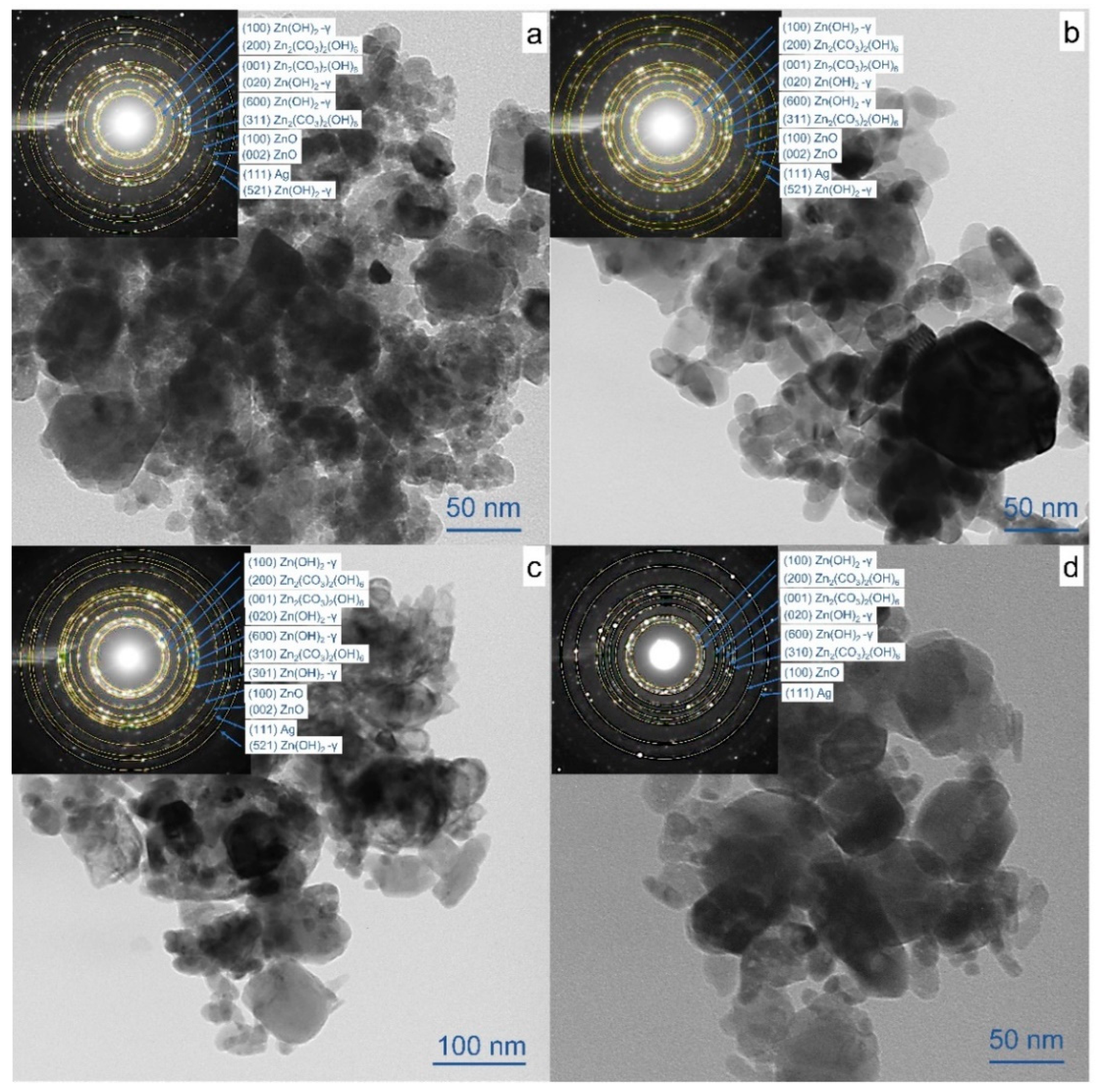
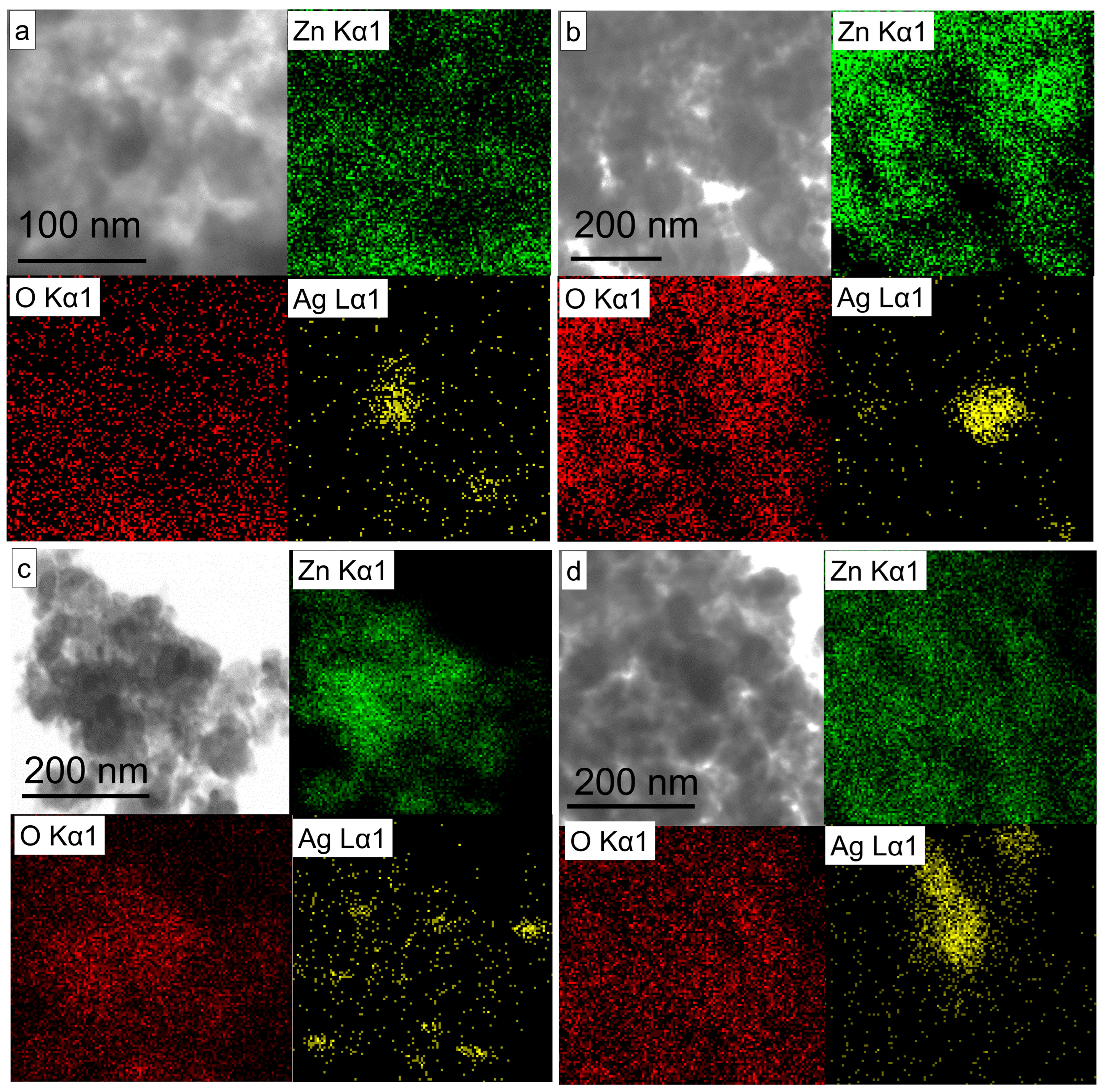
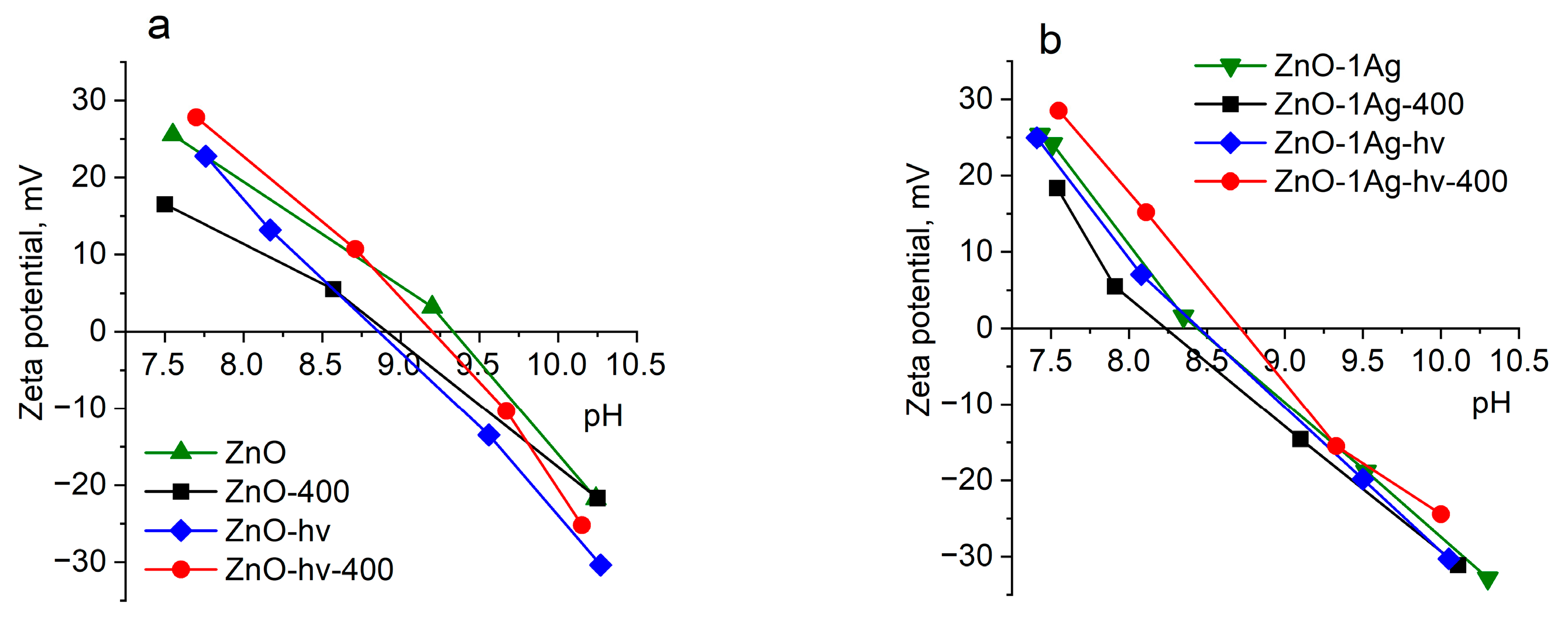
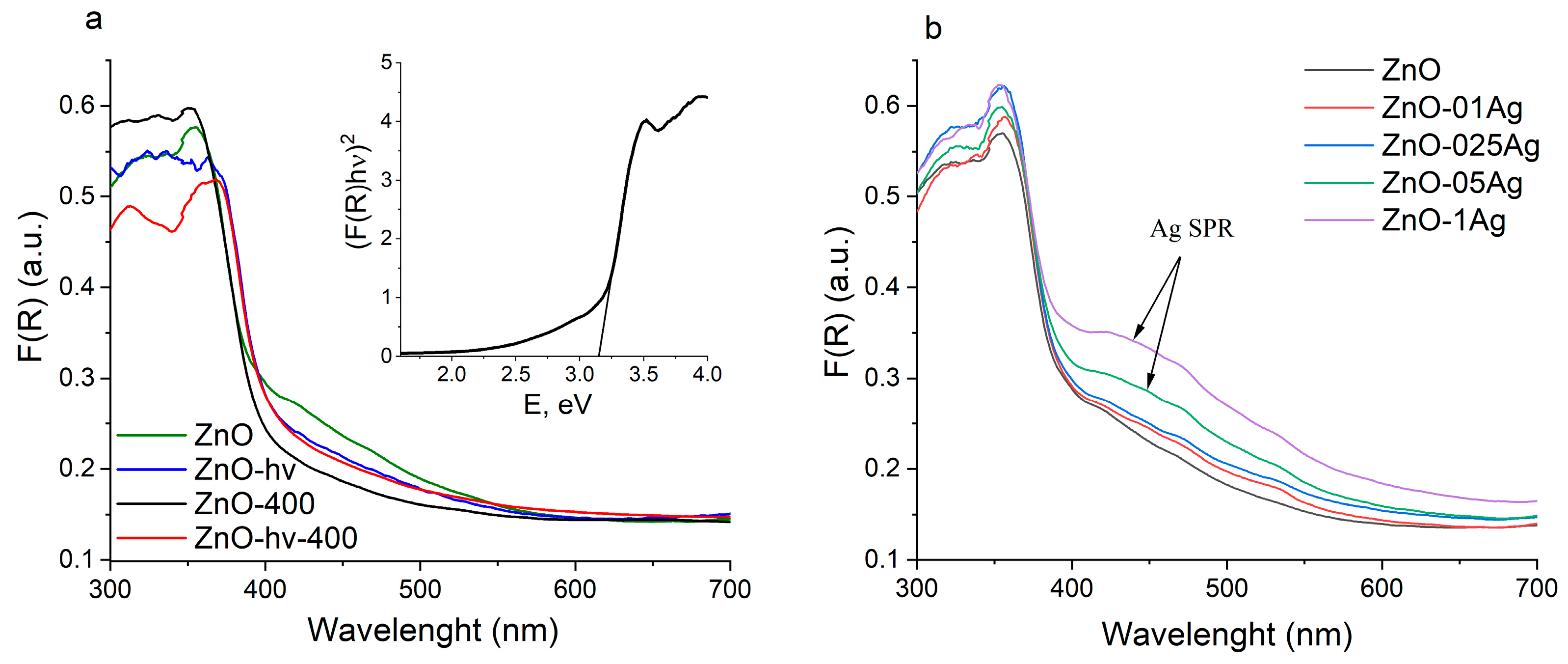



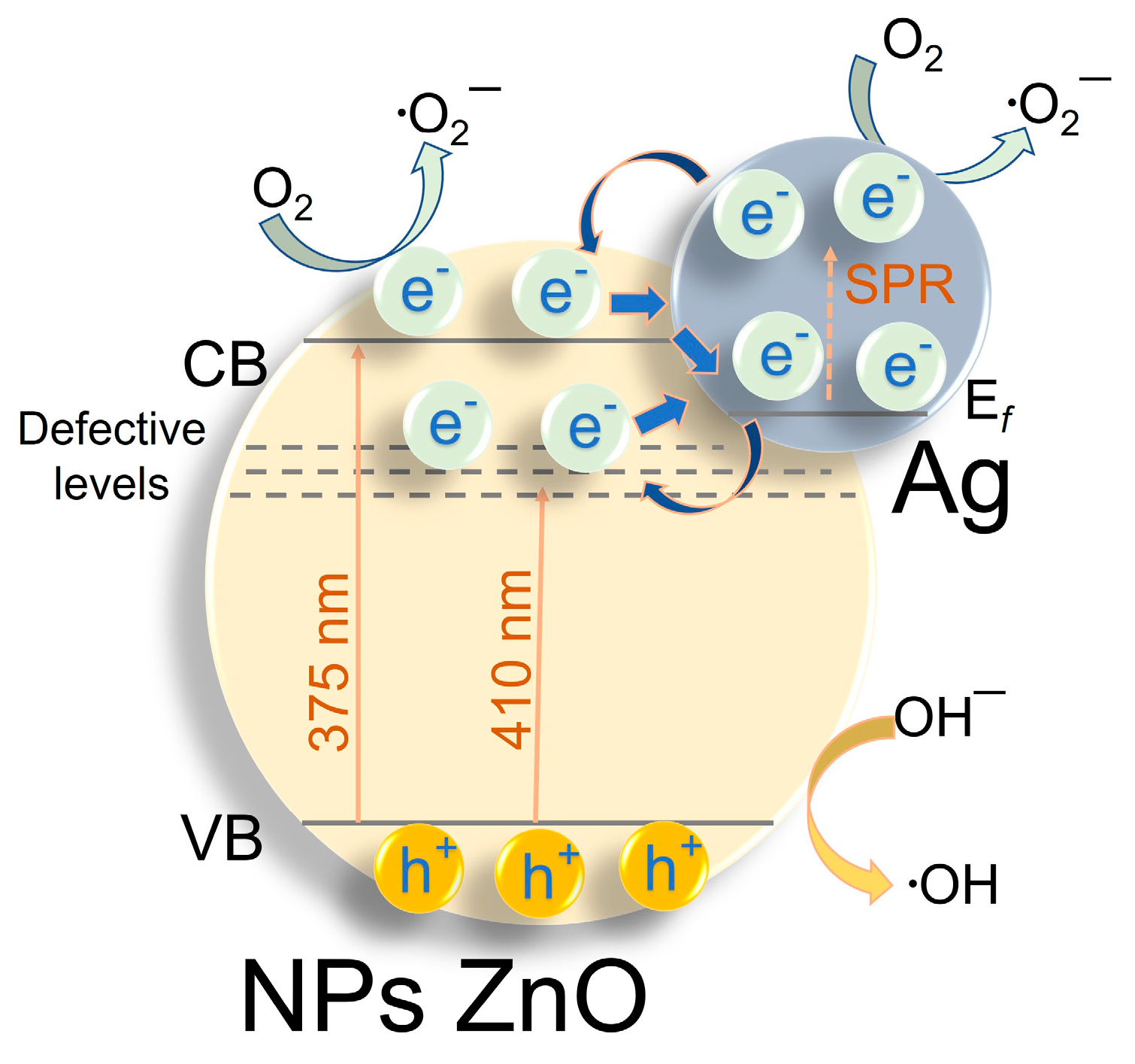


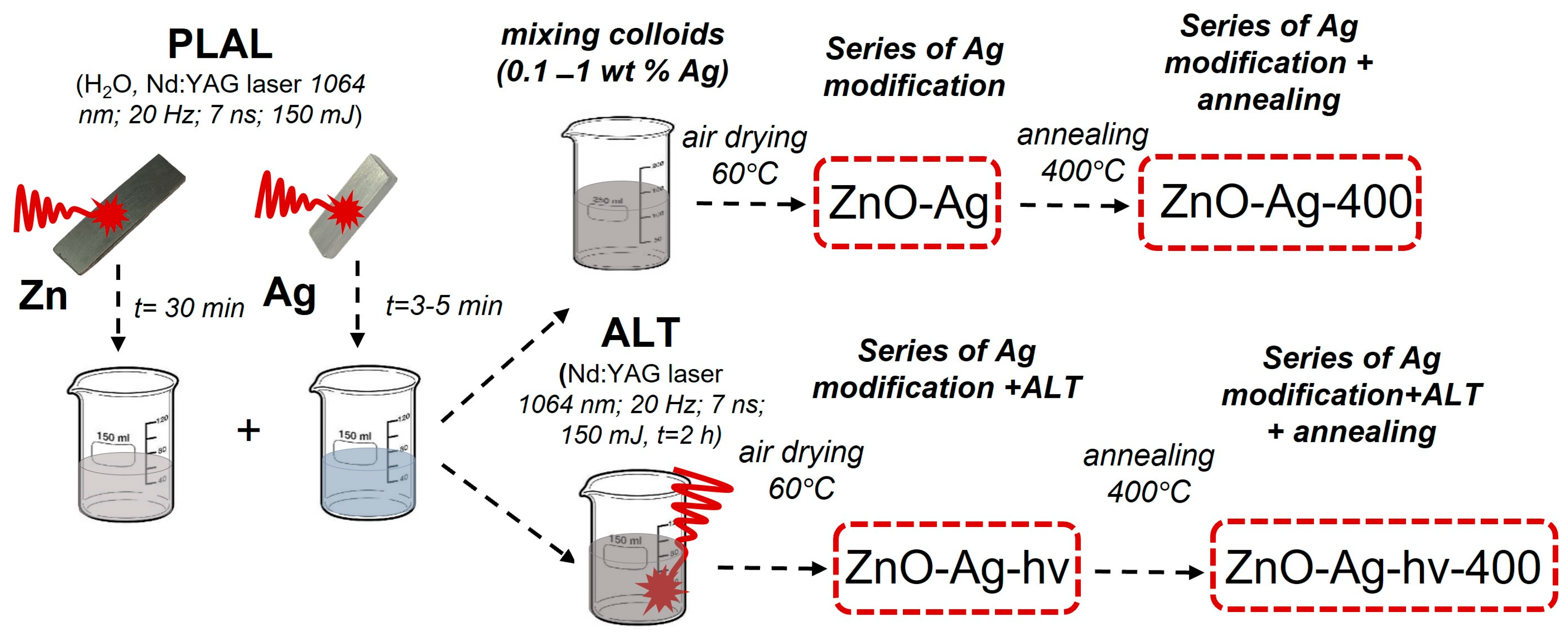
| Sample | Sample Composition | CSR *, nm | Ag Content, wt.% ** | SBET m2/g | Band Gap * | ||
|---|---|---|---|---|---|---|---|
| Phase | % | Tauc, eV | DASF, eV | ||||
| Non-modified samples (as-prepared) | |||||||
| ZnO | ZnO | 90 | 37 | – | 36 | 3.29 | 3.31 |
| Zn2(CO3)2(OH)6 | 10 | ||||||
| ZnO-400 | ZnO | 100 | 43 | – | 21 | 3.25 | 3.27 |
| Non-modified samples + ALT | |||||||
| ZnO_hν | ZnO | 95 | 62 | – | 23 | 3.11 | 3.28 |
| Zn2(CO3)2(OH)6 | 5 | ||||||
| ZnO-hν-400 | ZnO | 100 | 62 | – | 13 | 3.14 | 3.25 |
| Ag-modified samples | |||||||
| ZnO-01Ag | ZnO | 90 | 36 | 0.13 | 40 | 3.30 | 3.31 |
| Zn2(CO3)2(OH)6 | 10 | ||||||
| ZnO-025Ag | ZnO | 94 | 36 | 0.28 | 40 | 3.29 | 3.32 |
| Zn2(CO3)2(OH)6 | 6 | ||||||
| ZnO-05Ag | ZnO | 93 | 37 | 0.49 | 40 | 3.29 | 3.32 |
| Zn2(CO3)2(OH)6 | 6 | ||||||
| Ag | ~1 | ||||||
| ZnO-1Ag | ZnO | 93 | 37 | 0.98 | 40 | 3.30 | 3.32 |
| Zn2(CO3)2(OH)6 | 6 | ||||||
| Ag | 1 | ||||||
| Ag modification + annealing | |||||||
| ZnO-01Ag-400 | ZnO | 100 | 40 | 0.13 | 18 | 3.25 | 3.26 |
| ZnO-025Ag-400 | ZnO | 100 | 38 | 0.28 | 19 | 3.25 | 3.26 |
| ZnO-05Ag-400 | ZnO | 99 | 35 | 0.49 | 21 | 3.24 | 3.26 |
| Ag | ~1 | ||||||
| ZnO-1Ag-400 | ZnO | 99 | 35 | 0.98 | 26 | 3.25 | 3.27 |
| Ag | 1 | ||||||
| Ag modification + ALT | |||||||
| ZnO-01Ag-hν | ZnO | 95 | 40 | 0.13 | 39 | 3.10 | 3.29 |
| Zn2(CO3)2(OH)6 | 5 | ||||||
| ZnO-025Ag-hν | ZnO | 95 | 38 | 0.28 | 38 | 3.10 | 3.29 |
| Zn2(CO3)2(OH)6 | 5 | ||||||
| ZnO-05Ag-hν | ZnO | 93 | 39 | 0.49 | 35 | 3.10 | 3.31 |
| Zn2(CO3)2(OH)6 | 7 | ||||||
| ZnO-1Ag-hν | ZnO | 93 | 40 | 0.98 | 36 | 3.06 | 3.31 |
| Zn2(CO3)2(OH)6 | 7 | ||||||
| Ag modification + ALT+ annealing | |||||||
| ZnO-01Ag-hν-400 | ZnO | 100 | 41 | 0.13 | 27 | 3.12 | 3.25 |
| ZnO-025Ag-hν-400 | ZnO | 100 | 42 | 0.28 | 29 | 3.13 | 3.27 |
| ZnO-05Ag-hν-400 | ZnO | 100 | 40 | 0.49 | 26 | 3.11 | 3.27 |
| ZnO-1Ag–hν-400 | ZnO | 100 | 38 | 0.98 | 26 | 3.10 | 3.28 |
| Sample | pHo | ζo, mV | pHIEP |
|---|---|---|---|
| ZnO | 7.6 | 25.5 | 9.3 |
| ZnO-400 | 7.5 | 16.5 | 8.9 |
| ZnO-hν | 7.7 | 22.8 | 8.8 |
| ZnO-hν-400 | 7.7 | 27.8 | 9.2 |
| ZnO-1Ag | 7.4 | 25.3 | 8.4 |
| ZnO-1Ag-400 | 7.5 | 18.4 | 8.2 |
| ZnO-1Ag-hν | 7.4 | 25.0 | 8.4 |
| ZnO-1Ag-hν-400 | 7.6 | 28.5 | 8.4 |
| Synthesis Conditions | Parameters of Photocatalytic Experiment | Reaction Rate Constant for Best Sample | Refs. | |
|---|---|---|---|---|
| Pollutant, Concentration/Catalyst Loading | Light Source, Power | |||
| Laser approach synthesis | ||||
| PLA Zn plate in H2O + PLA Ag plate in ZnO colloid (Nd:YAG laser, 1064 nm, 160 µs, 100 mJ) | Rhodamine 6G, ~10−5 M/ 2 mL of colloidal NPs | UV lamps (Sankyo Denki, Japan), 8 W, peak at 352 nm | 0.0167 min−1 ZnO-Ag3 (Ag 23.4%) | [37,38] |
| PLA Zn plate in H2O (Nd:YAG laser (1064 nm, 7 ns, 90 mJ), calcined at 500 °C + photoreduction of Ag from AgNO3 | Lindane (C6H6Cl6) 5 × 10−5 M/0.5 g/L NPs | UV–vis xenon lamp, 200 W | 0.0352 min−1 ZnO/Ag (Ag~3%) | [40] |
| PLA Zn plate in isopropanol (Nd:YAG laser (532 nm, 7 ns, 25 mJ) + laser photoreduction of Ag from AgNO3 + calcined at 500 °C | Methylene blue (MB) 5 µg/0.15 g NPs | UV-Vis high-pressure sodium lamp | 0.00547 min−1 2 wt%Ag/ZnO (at pH 11) | [41] |
| PLA Zn plate in H2O + PLA Ag plate in ZnO colloid (800 nm, 90 fs, 3.5 mW, 1 kHz) | MB 10 mg/L/ 0.33 g/L NPs | 250 W metal halide lamp (GE ARC250/T/H/ 960E40) | 0.0419 min−1 6 wt% Ag/ZnO at pH 10) | [49] |
| PLA Ag-coated ZnO target in H2O (Nd:YAG laser (1064 nm, 5 ns, 300 mJ) | MB 2.7 × 10−5 M/ ~0.1 g/l NPs | UV-vis Hg lamp, VIS 2.11 klx, UVA 0.2 mW/cm2, UVB 0.02 mW/cm2, UVC 0.08 mW/cm2 | 0.0233 min−1 Zn_1000Ag (0.32%) | [61] |
| PLA Zn plate in H2O + PLA Zn plate in H2O + ALT of mixed solution (1064 nm, 7 ns, 150 mJ) | Rh B 5 × 10−6 M Phen 5 × 10−5 M TC 5 × 10−5 M/ 0.5 g/L NPs | LED 375 nm, 50 mW | Rh B, 0.0209 min−1 ZnO-1Ag-hν Phen, 0.0019 min−1 ZnO-1Ag-hν TC, 0.0589 min−1 ZnO-1Ag-hν | This work |
| Other ways of synthesis | ||||
| Ultrasonic microwave-assisted method for ZnO + thermal reduction of Ag from AgNO3 | Rh B, methylene orange 1 × 10−5 M/ 0.5 g/L NPs | 500 W Xe lamp with a 400 nm cut-off filter | 0.0431 min−1 ZnO/Ag (Ag~10%) | [62] |
| Microwave-assisted one-pot method of Ag/ZnO synthesis with thermal reduction of Ag from AgNO3 | Rh B 2.1 × 10−5 M/ 1.5 g/L NPs | Xe lamp 300 W and AM 1.5 filter were used as the simulated solar light. | 0.1732 min−1 Ag:ZnO (8:92) | [27] |
| Hydrothermal method for ZnO and further loaded via precipitation with Ag (photo deposition from AgNO3) and CDots | TC 6.8 × 10−5 M/ 1 g/L NPs | UV-vis xenon lamp, 150 W (300–780 nm) | 0.03389 min−1 Ag/ZnO 0.0489 min−1 CDots/Ag/ZnO | [63] |
Disclaimer/Publisher’s Note: The statements, opinions and data contained in all publications are solely those of the individual author(s) and contributor(s) and not of MDPI and/or the editor(s). MDPI and/or the editor(s) disclaim responsibility for any injury to people or property resulting from any ideas, methods, instructions or products referred to in the content. |
© 2024 by the authors. Licensee MDPI, Basel, Switzerland. This article is an open access article distributed under the terms and conditions of the Creative Commons Attribution (CC BY) license (https://creativecommons.org/licenses/by/4.0/).
Share and Cite
Fakhrutdinova, E.D.; Volokitina, A.V.; Kulinich, S.A.; Goncharova, D.A.; Kharlamova, T.S.; Svetlichnyi, V.A. Plasmonic Nanocomposites of ZnO-Ag Produced by Laser Ablation and Their Photocatalytic Destruction of Rhodamine, Tetracycline and Phenol. Materials 2024, 17, 527. https://doi.org/10.3390/ma17020527
Fakhrutdinova ED, Volokitina AV, Kulinich SA, Goncharova DA, Kharlamova TS, Svetlichnyi VA. Plasmonic Nanocomposites of ZnO-Ag Produced by Laser Ablation and Their Photocatalytic Destruction of Rhodamine, Tetracycline and Phenol. Materials. 2024; 17(2):527. https://doi.org/10.3390/ma17020527
Chicago/Turabian StyleFakhrutdinova, Elena D., Anastasia V. Volokitina, Sergei A. Kulinich, Daria A. Goncharova, Tamara S. Kharlamova, and Valery A. Svetlichnyi. 2024. "Plasmonic Nanocomposites of ZnO-Ag Produced by Laser Ablation and Their Photocatalytic Destruction of Rhodamine, Tetracycline and Phenol" Materials 17, no. 2: 527. https://doi.org/10.3390/ma17020527
APA StyleFakhrutdinova, E. D., Volokitina, A. V., Kulinich, S. A., Goncharova, D. A., Kharlamova, T. S., & Svetlichnyi, V. A. (2024). Plasmonic Nanocomposites of ZnO-Ag Produced by Laser Ablation and Their Photocatalytic Destruction of Rhodamine, Tetracycline and Phenol. Materials, 17(2), 527. https://doi.org/10.3390/ma17020527








